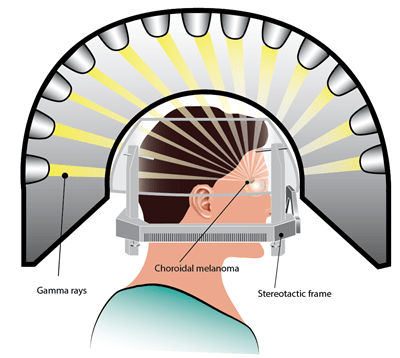Gamma Knife Stereotactic Radiosurgery
Legacy Devers Eye Institute
Gamma knife stereotactic radiosurgery
Gamma Knife Stereotactic radiosurgery (GK-SRS) is a highly precise form of radiation therapy that was designed to treat tumors and lesions in the brain. Even though it is called surgery, radiosurgery does not involve actual surgery. In addition, there is no knife either. With regards to ocular melanoma and choroidal metastases, stereotactic radiosurgery has a more than 20-year long track record as a valid method that achieves comparable tumor control rates, as compared with other forms of radiation treatment. Legacy Devers Eye Institute is the only institution in the Pacific Northwest offering this treatment modality for patients with ocular malignancies.
How it works:
The stereotactic radiosurgery machine uses narrow beams of gamma radiation to target the tumor. A metallic helmet that surrounds the patient’s head helps to precisely focus the radiation beam. The radiation distorts or destroys the DNA of the tumor cells, which stops them from growing and thereby inducing shrinkage of the tumor.

How is it done:
A Gamma Knife procedure for the treatment of ocular melanoma involves a multidisciplinary team. The team members may involve:
- Neurosurgeon (MD)
- Ocular oncologist (MD)
- Radiation oncologist (MD)
- Registered nurse (RN)
- Medical physicist
Gamma Knife treatment is a one-day, outpatient procedure and generally involves these four steps:
- Head frame placement. In order to keep the head from moving during treatment, a box-shaped frame is attached to the head. Pins designed specifically for this purpose fasten the head frame to the skull. The head frame also is a guide to focus the gamma ray beams to the exact location of the lesion being treated.
- Tumor location imaging. Once the head frame is in place, the exact location of the lesion to be treated will be determined using a CT scan or MRI
- Radiation dose planning. After the CT scan or MRI has been completed, the radiation therapy team will determine the treatment plan. The results of the imaging scan, along with other information, will be used by a medical physicist to determine the best treatment.
- Radiation treatment. After being positioned for the treatment, a type of helmet with many hundreds of holes in it is placed over the head frame. These holes help to focus the radiation beams on the target. Treatment will last a few minutes up to a few hours. This depends on the type and location of the area being treated. Generally, only one treatment session is needed for a lesion.
Indications:
GK-SRS is an efficacious primary method of treating uveal melanomas and choroidal metastases, with reliable tumor control rates. GK-SRS is particularly helpful for:
- Patients with large intraocular melanomas not amenable to plaque radiotherapy.
- Choroidal melanomas with extrascleral extension.
- Choroidal melanomas in close proximity to the optic nerve.
- Patients who are systemically unwell and cannot tolerate general anesthesia.

